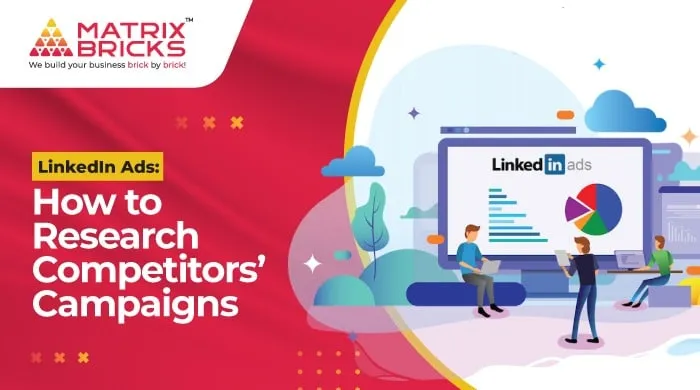
The famous Chinese general, military strategist, and philosopher Sun Tzu said that you need to know your enemies well that is, read their minds, to win the war. While we are not saying that every business opportunity is a battle and that your competitors are your sworn enemies (we are), they are though, your competition and that’s something you must look out for.

But just how and where do you begin?

You begin by reading our curated list of surefire ways of getting an edge over your competitors by cracking their LinkedIn Ads.
1. Find your competitors’ LinkedIn Ads
Start by making a list of the competitors you want to assess. A list that contains 3-5 names of the competitors in your league should do.
Once you have the list, enter the name of the competitor in the search bar and access their page. After this, follow the steps shown below:


In most cases, these ads function just like they would if they appeared in your feed. You can typically click through them to view the linked landing page, where you can learn more about the brand positioning and what the brand offers.
From the ad, you can view everything from the creative pitch to the call-to-action (CTA) buttons, etc. pc/ ANT OPEN
Note: The Ads tab only displays the present LinkedIn ads, not past campaigns.
2. Use the LinkedIn feed to research Ads and fuel ideas
While it’s helpful to have a list of competitors to research ads from, we also suggest looking out for LinkedIn campaigns of businesses from ~outside~ of your industry, as these can also provide powerful insights and help improve your marketing.
Whenever you spot an interesting ad in your feed, simply follow the steps below and the post will get saved in your personal library.
create ads that meet your goals more efficiently. By saving enough ads over a period of time, you will have curated a Reference Library for later use. A similar workflow is followed on your phone, to save your desired ads.
The second tool in your arsenal is learning how to uncover your competitor’s target audience. You do this by clicking on the aforementioned three dots, and then following the steps shown below –



You’ll be shown the reasons why your (the reader’s) profile fits the Ad’s TA, which will then provide some much-needed facts.
It can be for a number of reasons that your competitor is targeting someone (like the three stated above). In any case, clicking on any of these reasons further reveals even more information, including the specific reason the competitor is targeting people.

3. Use Competitive Research to Improve Your LinkedIn Ads
Now that you have your hands on the competitor’s ads on LinkedIn, it’s time to dig deep and use the research for creating better ad campaigns!
Before we go there, here’s a brief introduction to what an ad funnel is and why it’s important for your business.
Once you understand what an ad funnel is, you’ll realize why you need to be making a note of your competitors’ awareness-focused ads. This practice helps you find out just how they’re creating a buzz around their brand.
You can follow this up by looking for ads that drive website traffic or encourage on-page engagement. And then, pinpoint the ads that are designed to generate leads and secure conversions. By this point, you’ll have identified ads for all three stages of the funnel.
Not only this but spying on understanding your competitor’s ads also helps you realize what not to do on the platforms and saves you some slips along the way 😉
Besides this, writing a compelling Ad copy for LinkedIn also puts your research to good use.

This one is a no-brainer as good content forms the bedrock of what hooks a customer in and makes them engage with your brand! It goes without saying that your copywriting needs to resonate with your audience.
But what exactly are the elements of a good copy? First and foremost, a good copy will have an interesting initial hook that draws potential customers in right away! It can be both, a question or a statement.
Next, clearly stressing the benefits your prospects get from your offer is also a big win. Copies that fail to do this, also fail to deliver.
Along with this, having your copy talk about the pain points of your prospects and how your product/ service caters to them also helps you gain mileage. Remember that people anywhere just want to know why they should invest in your brand, over a brand x, and elaborating on these points just helps display your USPs more strongly!
And finally, try coming up with CTA’s that push specific action and are placed decisively on multiple copy fields to get you traction.
Broadening your creative library by keeping a keen eye on LinkedIn ads is yet another way your storytelling gets amped up and encourages better interaction.
You could begin by experimenting with brand introduction videos, customer case study videos, team or office photos, product photography, graphics in your brand style, motion graphics or animation of a different style, text overlays, etc.
To sum it up, learning what and how your competition’s ads are doing can give you powerful insights into what’s working in real time. It can help upgrade your LinkedIn advertising creatives, copy, landing pages, UX, offers, and more.
By engaging in competitive research with the tactics mentioned above, your research process is poised to become streamlined and you’ll find inspiration to





